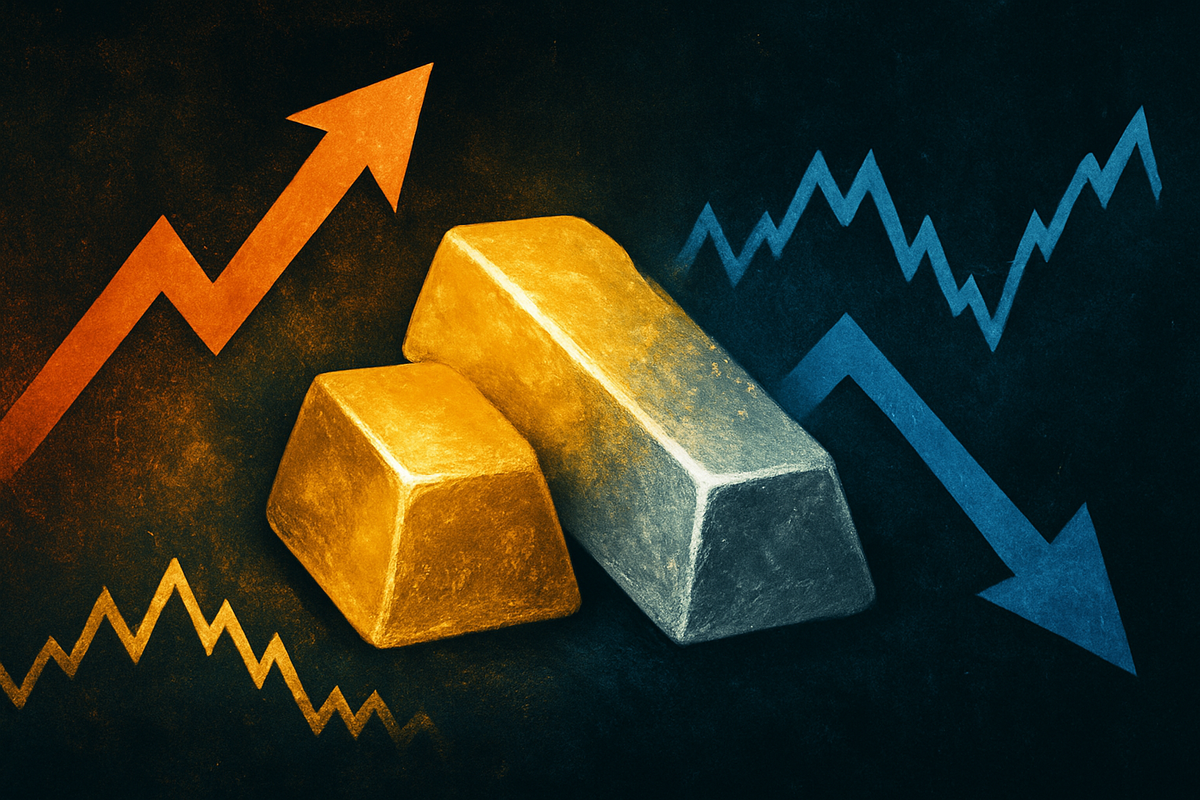
The global financial landscape is currently gripped by an extraordinary phenomenon in the precious metals sector, as gold and silver markets experience a period of unprecedented volatility. Dubbed a "wild ride" by market analysts, this era is characterized by historic price surges that have seen both metals reach new all-time highs, only to be swiftly followed by sharp and significant declines. This intense fluctuation presents a complex challenge for investors, demanding a re-evaluation of traditional strategies and a keen eye on market dynamics as the world navigates a confluence of economic and geopolitical uncertainties.
The immediate implications of this extreme volatility are profound, shaking investor confidence while simultaneously presenting unique opportunities for those agile enough to navigate the choppy waters. As a safe-haven asset class, the erratic behavior of gold and silver reflects deeper anxieties within the global financial system, signaling a period of heightened risk and potential reordering of capital flows. For individual and institutional investors alike, understanding the drivers behind these dramatic swings is paramount to safeguarding portfolios and capitalizing on emerging trends in a market that seems to redefine its boundaries daily.
A Rollercoaster of Records and Retracements
The past two years, particularly 2024 and 2025, have been nothing short of historic for gold and silver. Gold prices have witnessed a remarkable ascent, culminating in an unprecedented nominal high of approximately $4,379.96 per ounce internationally on October 16, 2025, with spot gold trading around $4,323.69 per ounce on October 21, 2025. This surge represents an astonishing gain of over 60% since the start of 2025, surpassing even the inflation-adjusted peak from February 1980. The yellow metal's journey included breaking the $3,000 mark by mid-March 2025 and adding another $1,000 in subsequent months. However, the 'wild ride' lived up to its name, with gold experiencing a swift correction, dropping nearly 2% from its peak by October 21, 2025, as investors locked in profits.
Silver's trajectory has been even more dramatic, exhibiting heightened volatility characteristic of its smaller market size and dual role as both a precious and industrial metal. It reached an all-time high of $54.3775 per ounce around mid-October 2025, shattering its previous record set in 1980. Silver's rally has been astounding, surging nearly 87% since the beginning of 2025 and boasting a year-to-date gain exceeding 70%. Yet, its susceptibility to sharp declines was starkly evident on October 17, 2025, when it plunged over 6% in its most dramatic single-session decline in six months. By October 21, 2025, silver futures had fallen to $50.50 per ounce, with spot silver retreating more than 5% below $50 per ounce.
This intense market activity is driven by a complex interplay of factors. Geopolitical tensions, including ongoing conflicts in Ukraine and the Middle East, coupled with US-China relations, have significantly fueled the safe-haven demand for precious metals. Furthermore, expectations of aggressive monetary easing by central banks, particularly anticipated interest rate cuts by the Federal Reserve, have decreased the opportunity cost of holding non-yielding assets like gold and silver. Persistent inflation concerns and a weakening U.S. dollar have also bolstered their appeal as hedges against currency devaluation. For silver, robust industrial demand from green technologies, such as solar panels and electric vehicles, combined with supply inelasticity, has amplified its price movements. The 'mini short squeeze' in the silver market due to tight supply has further exacerbated its volatility.
Navigating the Shifting Sands: Winners and Losers in the Volatility
The unprecedented volatility in gold and silver markets creates a distinct landscape of winners and losers among public companies, particularly those involved in mining, precious metals streaming, and investment.
Mining companies with significant exposure to gold and silver reserves stand to gain substantially during price surges. Companies like Barrick Gold Corp. (NYSE: GOLD) and Newmont Corporation (NYSE: NEM), two of the largest gold producers globally, benefit from higher realized prices for their output, leading to increased revenues and potentially fatter profit margins. Similarly, silver-focused miners such as Pan American Silver Corp. (NASDAQ: PAAS) and Wheaton Precious Metals Corp. (NYSE: WPM), a streaming and royalty company, see their asset values appreciate and cash flows improve when prices are on an upward trajectory. However, these gains are often tempered by the sharp declines; a sudden drop in prices can quickly erode profitability, especially for companies with higher operating costs or those that have not hedged their production. Companies with strong balance sheets and efficient operations are better positioned to weather these downturns and even acquire distressed assets during market corrections.
Conversely, companies heavily reliant on gold and silver as raw materials for industrial applications might face increased input costs during price surges. Jewelers, electronics manufacturers, and solar panel producers could see their profit margins squeezed if they cannot pass on the increased costs to consumers. While the research highlights strong industrial demand for silver in green technologies, the extreme price swings introduce significant uncertainty into their supply chain management and budgeting. For instance, a solar panel manufacturer's (e.g., First Solar, Inc. (NASDAQ: FSLR)) profitability could be impacted by sudden spikes in silver prices, even if long-term demand for their products remains strong.
Investment firms and exchange-traded fund (ETF) providers specializing in precious metals can also experience both booms and busts. Funds like the SPDR Gold Shares (NYSEARCA: GLD) and iShares Silver Trust (NYSEARCA: SLV) see increased trading volumes and asset under management (AUM) during periods of high interest and rising prices, generating higher management fees. However, sharp declines can lead to significant outflows and reduced AUM. Brokerage firms that facilitate trading in these volatile commodities may also see increased commission revenues during periods of high activity, but they also bear the risk of increased margin calls and potential client defaults if positions turn sour quickly. Ultimately, companies with robust risk management frameworks, diversified operations, and the ability to adapt quickly to market shifts are the most likely to emerge as long-term winners in this volatile environment.
Wider Significance: A Barometer of Global Instability
The unprecedented volatility in gold and silver markets is not an isolated event but rather a potent barometer reflecting deeper structural stresses within the global financial system and broader industry trends. The 'wild ride' of precious metals underscores their enduring role as safe-haven assets, particularly during periods of profound economic uncertainty and geopolitical upheaval. This phenomenon fits squarely into a broader trend where traditional financial assets are increasingly susceptible to external shocks, driving investors towards tangible stores of value.
The ripple effects of this volatility extend beyond the immediate precious metals sector. Competitors in other asset classes, such as government bonds and certain equities, may experience shifts in investor allocations as capital seeks refuge or higher returns. For instance, a sustained rally in gold could divert funds from less secure fixed-income instruments. Furthermore, the heightened price swings in silver, driven partly by its critical role in green technologies, highlight the vulnerability of the burgeoning renewable energy sector to commodity market instability. This could prompt strategic pivots in supply chain management for companies reliant on silver, encouraging diversification or exploration of alternative materials.
Regulatory bodies are also likely to scrutinize these markets more closely. Periods of extreme volatility can invite concerns about market manipulation, speculative excesses, and the adequacy of existing trading safeguards. Historical precedents, such as the "Silver Thursday" in March 1980 when prices collapsed after attempts by the Hunt brothers to corner the market, serve as stark reminders of the potential for market dysfunction and the need for robust oversight. Similarly, the 1970s and early 1980s saw gold prices quadruple amidst double-digit inflation and oil shocks, followed by sharp declines due to aggressive monetary policy (the Volcker shock). These historical parallels suggest that while current drivers like geopolitical tensions and monetary policy expectations are unique to this era, the underlying dynamics of fear, inflation hedging, and speculative interest remain constant, necessitating careful monitoring by policymakers.
What Comes Next: Navigating the Future of Precious Metals
Looking ahead, the gold and silver markets are poised for continued dynamism, with both short-term fluctuations and long-term trends shaping their trajectory. In the short term, investors should anticipate ongoing volatility, particularly as global geopolitical tensions persist and central banks continue to signal shifts in monetary policy. Any further escalation in international conflicts or unexpected changes in interest rate forecasts could trigger rapid price movements. Corrections, like those observed in late October 2025, may present strategic buying opportunities for long-term investors looking to average into positions before the next potential growth cycle.
Long-term possibilities for both metals remain largely bullish, according to many market analysts. Gold is widely expected to continue its role as a primary hedge against inflation and currency debasement, especially given concerns about rising sovereign debt levels and the potential for a weakening U.S. dollar. J.P. Morgan Research, for instance, anticipates gold prices to average $3,675/oz by the final quarter of 2025, potentially rising toward $4,000/oz by the second quarter of 2026. Bank of America goes even further, projecting gold could reach $5,000 per ounce in 2026. Silver, with its dual appeal as an investment and industrial metal, is also forecasted for significant growth, with Bank of America raising its 2026 forecast to $65 per ounce and some predictions even reaching $200 or higher by 2030, driven by sustained industrial demand from green technologies.
Potential strategic pivots or adaptations required from market participants include a greater emphasis on diversification within precious metals portfolios, perhaps maintaining a balanced gold-to-silver ratio (e.g., 70% gold to 30% silver) to mitigate risks. Dollar-cost averaging could become an increasingly popular strategy to smooth out the impact of price swings. Market opportunities may emerge in derivatives markets, allowing sophisticated investors to hedge against volatility or speculate on price movements. Challenges include managing the psychological impact of rapid price changes and avoiding impulsive decisions based on short-term market noise. Potential scenarios range from a continued upward trend fueled by persistent global instability to sharper corrections if geopolitical tensions ease or central banks adopt a more hawkish stance than anticipated.
Comprehensive Wrap-up: Enduring Value Amidst Turbulent Times
The unprecedented volatility witnessed in the gold and silver markets throughout 2024 and 2025 has indelibly marked this period as one of historic significance. The 'wild ride' of record-breaking surges followed by sharp declines underscores the complex interplay of geopolitical instability, evolving monetary policies, inflationary pressures, and distinct supply-demand dynamics that currently define these critical asset classes. Key takeaways include the reassertion of precious metals' safe-haven appeal in times of uncertainty, the amplified risk and reward profile of silver due to its smaller market and industrial demand, and the necessity for investors to adopt disciplined, strategic approaches.
Moving forward, the market for gold and silver is expected to remain highly dynamic. While short-term fluctuations are a given, the long-term outlook for both metals appears robust, supported by fundamental drivers such as persistent inflation, currency devaluation concerns, and strong industrial demand for silver in the green energy transition. The current environment, characterized by deep structural stress in the global financial system, positions gold and silver as potential "lifeboats in a storm," offering diversification and a hedge against broader market downturns.
For investors, the coming months will demand vigilance and a nuanced understanding of market signals. Key factors to watch include central bank interest rate decisions, particularly from the Federal Reserve, developments in major geopolitical flashpoints, and global inflation data. Monitoring the U.S. dollar's strength and industrial demand trends for silver will also be crucial. While the allure of quick gains can be tempting in such volatile markets, a focus on long-term wealth preservation, strategic diversification, and a cautious approach to buying dips rather than chasing peaks will likely serve investors best in navigating this exhilarating yet challenging era for precious metals.
This content is intended for informational purposes only and is not financial advice





